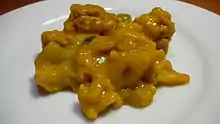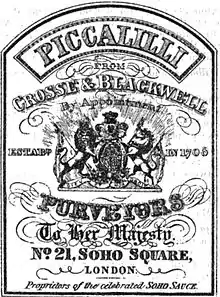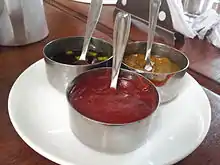Piccalilli
Piccalilli, or mustard pickle, is a British[1] interpretation of South Asian pickles, a relish[2][3] of chopped, pickled, vegetables and spices.[4] Regional recipes vary considerably.
 Mustard piccalilli | |
| Place of origin | Britain |
|---|---|
| Main ingredients | pickled vegetables and spices |
Etymology
The Oxford English Dictionary traces the word to the middle of the 18th century when, in 1758, Hannah Glasse described how "to make Paco-Lilla, or India Pickle".[5] An apparently earlier reference is in Anne Blencowe's Receipt Book, written c. 1694, which has "To Pickle Lila, an Indian Pickle" credited to Lord Kilmory.[6]
The more familiar form of the word appears in 1769, in Elizabeth Raffald's The Experienced English Housekeeper, as "To make Indian pickle, or Piccalillo".[7] Richard Briggs, in his 1788 The English Art of Cookery, similarly calls it "Picca Lillo".[8] The spelling "piccalilli" can be seen in an advertisement in a 1799 edition of The Times.[9]
British piccalilli

British piccalilli contains various vegetables—regularly cauliflower, onion, and gherkin—and seasonings of mustard and turmeric. A more finely chopped variety "sandwich piccalilli" is also available from major British supermarkets. It is used as an accompaniment to foods such as sausages, bacon, eggs, toast, cheese, and tomatoes. It is usually used to accompany a dish on a plate rather than as a bread spread. It is popular as a relish with cold meats such as ham and brawn, and with a ploughman's lunch. It is produced both commercially and domestically, being a traditional mainstay of Women's Institute and farmhouse product stalls.
Cypriot piccalilli
An unsweetened variation of British piccalilli is found in Cyprus (including northern Cyprus). It is without baby onions, with a milder mustard sauce, and with the addition of carrot pieces. Piccalilli is known in Cyprus as πίκλα (pikla) in Cypriot Greek, and bikla in Cypriot Turkish. It is served as a condiment, and occasionally as a meze dish.
American piccalilli
In the Northeastern United States, commercial piccalillis are made with a base of sweet peppers or green tomatoes. This style is somewhat similar to sweet pepper relish, with the piccalilli being distinguished by having a darker red or green color and, like British piccalilli, the chunks are larger and it is slightly sweeter.[11][12] It is a popular topping on such foods as hamburgers and hot dogs. Traditional, British-style, yellow, piccalilli is also available.
In the Midwestern United States, commercial piccalillis are based on finely chopped gherkins. Bright green and on the sweet side, they are often used as a condiment for Chicago-style hot dogs. This style is sometimes called "neon relish".[13]
In the Southern United States, piccalilli is not commonly served.[14] In its place, chow-chow, a relish with a base of chopped green (unripe) tomatoes, is offered. This relish may also include onions, bell peppers, cabbage, green beans, and other vegetables. While not exactly similar to other piccalillis, chow-chow is often called as such and the terms may be used interchangeably.[15][16]
In the Western United States, piccalilli is uncommon.
Surinamese piccalilli
A far spicier variant of piccalilli comes from the former Dutch colony of Suriname, where traditional British piccalilli is mixed with a sambal made of garlic and yellow Madame Jeanette peppers. This piccalilli is often homemade but can also be bought in jars in Dutch corner shops. Whilst Surinamese piccalilli is similar in appearance to ordinary piccalilli, the taste is much spicier.
Media references
As a term for a mixed collection, piccalilli lends its name to several books of poems, for example, Piccalilli: A Mixture, by Gilbert Percy (1862),[17] and Dilly Dilly Piccalilli: Poems for the Very Young (1989), by Myra Cohn Livingston.[18] Mr Piccalilli is the name of a character in the children's book Mr Pod and Mr Piccalilli (2005), by Penny Dolan.[19]
The semi-autobiographical book Vet In Harness (published in North America as All Things Bright And Beautiful) by James Herriot includes an amusing anecdote in which Herriot uses a particularly spicy piccalilli to help make an unsavory meal more palatable and avoid offending his well-meaning hosts. This story was also published by Reader's Digest magazine (and several Herriot compilations) under the title "The Piccalilli Saves My Bacon".
Piccalilli receives an honorable mention in the Harry Champion song, "A Little Bit of Cucumber".
The song "Lily the Pink", recorded in 1968 by UK comedy group The Scaffold, includes a humorous reference to piccalilli when describing Lily's eventual demise, in the lyric "...and despite her medicinal compound, sadly Picca-Lily died".[20] The song was based on an earlier folk song "the Ballad of Lydia Pinkham", which celebrated a herbal remedy invented by the eponymous heroine, marketed from 1876 as "Lydia E. Pinkham's Vegetable Compound". The connection between piccalilli and the vegetable compound is in name only, as the recipes differ completely.
Arthur Rackham illustrated the old English story "Mr. and Mrs. Vinegar" and their home is labelled 'Piccalilli Cottage.'
In the play Arsenic and Old Lace, kindly old lady Martha Brewster uses her experience making piccalilli to create a recipe for poisoned wine.
See also
References
- Jahangir, Rumeana. (2009-11-26) How Britain got the hots for curry. BBC News. Retrieved on 2013-09-20.
- Albala, K. (2011). Food Cultures of the World Encyclopedia [4 volumes]: [Four Volumes]. ABC-CLIO. p. 286. ISBN 978-0-313-37627-6. Retrieved November 3, 2017.
- Sally Pasley (August 31, 2011. "Piccalilli". The Boston Globe.
- Spelling as per The Chambers Dictionary, 1994, ISBN 0-550-10255-8.
- H. Glasse, Art of Cookery, 6th Ed. 1758, ( page 377)
- Sharples, Lady Anne (2004) [1694]. The Receipt Book of Lady Ann Blencowe. Heartsease Books. p. 85. ISBN 978-0-952-23365-7.
- Elizabeth Raffald, The Experienced English Housekeeper, 7th ed., Sold by R. Baldwin, 1769, 384 pages ( page 337)
- Richard Briggs, The English Art of Cookery, 1st Ed. London: G. G. J. and J. Robinson, 1788, page 590.
- The Times 3 Jan 1799. (Advert)
- Robertson, Maxwell Alexander (1867). English reports annotated, Volume 1. The Reports and Digest Syndicate. p. 567 – via Google Books.
- "Make it don't buy it: piccalilli". www.lovefood.com.
- Piccalilli – The Boston Globe. Boston.com (2011-08-31). Retrieved on 2013-09-20.
- Zeldes, Leah A. (2010-07-20). "Origins of neon relish and other Chicago hot dog conundrums". Dining Chicago. Chicago's Restaurant & Entertainment Guide, Inc. Retrieved 2010-07-31.
- Piccalilli – Definition and Cooking Information. RecipeTips.com. Retrieved on 2013-09-20.
- Zeldes, Leah A. (2010-08-18). "Eat this! Chow chow and piccalilli pickle the Southern harvest". Dining Chicago. Chicago's Restaurant & Entertainment Guide, Inc. Retrieved 2010-09-10.
- Piccalilli (American) Archived 2012-05-25 at Archive.today. Practicallyedible.com. Retrieved on 2013-09-20.
- Gilbert Percy, Piccalilli: a mixture, Publisher: S. Low Son and Co., 1862. (at Internet Archive)
- Myra Cohn Livingston, Dilly dilly piccalilli: poems for the very young, Illustrated by Eileen Christelow, Publisher: M.K. McElderry Books, 1989, ISBN 0-689-50466-7, ISBN 978-0-689-50466-2, 68 pages.
- Penny Dolan, Mr Pod and Mr Piccalilli, Illustrated by Nick Sharratt, Publisher Walker Books, 2005, ISBN 0-7445-4066-6, ISBN 978-0-7445-4066-6, 32 pages.
- "The Scaffold - Lily The Pink Lyrics". www.lyricsmania.com. Retrieved 2020-10-13.
External links
| Look up piccalilli in Wiktionary, the free dictionary. |
